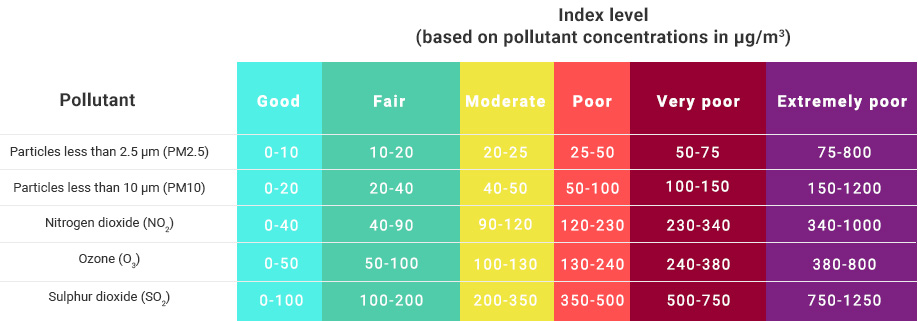Kosovo’s air quality standards are based on the EU’s air quality directives, (2008/50/EC Directive on Ambient Air Quality and Cleaner Air for Europe and 2004/107/EC Directive on heavy metals and polycyclic aromatic hydrocarbons in ambient air) and set pollutant concentrations thresholds that shall not be exceeded over a given period of time. The Air Quality Index (AQI) reflects the potential impact of poor air quality on health. It allows users to understand more about air quality where they live, work or travel. The AQI is a standard European Union approached for measuring, classifying and comparing air quality using a standard set of parameters. Displaying up-to-date information for Kosovo, users can gain insights into air quality in regions and cities. The AQI is based on the concentration of five key pollutants:
- particulate matter (PM10);
- fine particulate matter (PM2.5);
- ozone (O3);
- nitrogen dioxide (NO2);
- sulphur dioxide (SO2).
The AQI reflects the potential impact of air quality on health with the AQI level driven by the pollutant for which concentrations are highest. By default, the air quality index depicts the situation for the last full hour during which monitoring data has been collected. Users can also access historic and forecast data.
Kosovo environmental legislation is aligned with European Union air quality standards for both short-term (hourly or daily) and long-term (annual) air quality levels. Standards for long-term levels are stricter than for short-term levels, since serious health effects may occur from long-term exposure to pollutants.
The AQI indicates the short-term air quality situation. It does not reflect the long-term (annual) air quality situation, which may differ significantly. It should be noted that the AQI is not a tool for checking compliance with air quality standards and cannot be used for this purpose.
Methodology
The AQI uses current air quality data from the Kosovo monitoring station network and from forecast models.
Concentration values for 5 pollutants (PM10, PM2.5, SO2, NO2 and O3) determine the AQI level at each monitoring station. The AQI corresponds to the highest level for any of the 5 pollutants, according to the table shown below. Only 4 (out of the 5) pollutants are used for the AQI forecast: ozone, nitrogen dioxide, and particulate matter (PM10 and PM2.5).
Averaging time for pollutants
For NO2, O3 and SO2, hourly concentrations are used to calculate the AQI.
For PM10 and PM2.5, the 24-hour running averages are used to calculate the AQI.
Bands of concentrations and index levels
The bands are based on the relative risks associated to short-term exposure to PM2.5, O3 and NO2, as defined by the World Health Organization in its report on the Health Risks of Air Pollution in Europe project (HRAPIE project report, 2013).
The relative risk of exposure to PM2.5 is taken as the basis for the index, specifically the increase in the risk of mortality per 10 µg/m3 increase in the daily mean concentration of PM2.5.
Assuming linearity across the relative risks functions for O3 and NO2, we calculate the concentrations of these pollutants that pose an equivalent relative risk to a 10 µg/m3 increase in the daily mean of PM2.5.
For PM10 concentrations, a constant ratio between PM10 and PM2.5 of 1:2 is assumed, in line with the World Health Organization´s air quality guidelines for Europe.
For SO2, the bands reflect the limit values set under the EU Air Quality Directive.

Air quality measurements that exceed the maximum values in the “extremely poor” category are not taken into account for the index calculation, since these values are typically found to be erroneous.

